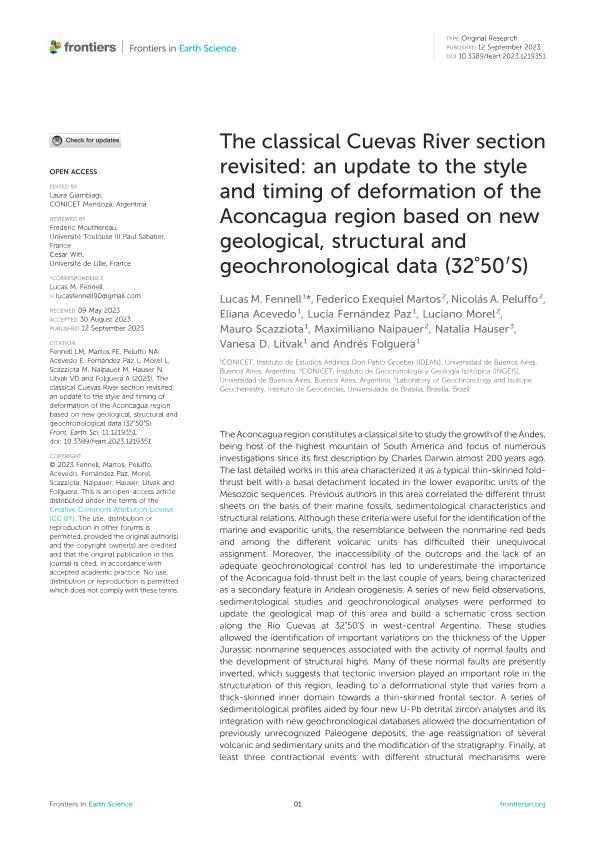Artículo
The classical Cuevas River section revisited: An update to the style and timing of deformation of the Aconcagua region based on new geological, structural and geochronological data (32°50′S)
Fennell, Lucas Martín ; Martos, Federico Exequiel
; Martos, Federico Exequiel ; Peluffo, Nicolas Alejandro
; Peluffo, Nicolas Alejandro ; Acevedo, Eliana Belén
; Acevedo, Eliana Belén ; Fernández Paz, Lucía
; Fernández Paz, Lucía ; Morel, Luciano
; Morel, Luciano ; Scazziota, Mauro
; Scazziota, Mauro ; Naipauer, Maximiliano
; Naipauer, Maximiliano ; Hauser, Natalia
; Hauser, Natalia ; Litvak, Vanesa Dafne
; Litvak, Vanesa Dafne ; Folguera Telichevsky, Andres
; Folguera Telichevsky, Andres
 ; Martos, Federico Exequiel
; Martos, Federico Exequiel ; Peluffo, Nicolas Alejandro
; Peluffo, Nicolas Alejandro ; Acevedo, Eliana Belén
; Acevedo, Eliana Belén ; Fernández Paz, Lucía
; Fernández Paz, Lucía ; Morel, Luciano
; Morel, Luciano ; Scazziota, Mauro
; Scazziota, Mauro ; Naipauer, Maximiliano
; Naipauer, Maximiliano ; Hauser, Natalia
; Hauser, Natalia ; Litvak, Vanesa Dafne
; Litvak, Vanesa Dafne ; Folguera Telichevsky, Andres
; Folguera Telichevsky, Andres
Fecha de publicación:
09/2023
Editorial:
Frontiers Media
Revista:
Frontiers in Earth Science
ISSN:
2296-6463
Idioma:
Inglés
Tipo de recurso:
Artículo publicado
Clasificación temática:
Resumen
The Aconcagua region constitutes a classical site to study the growth of the Andes, being host of the highest mountain of South America and focus of numerous investigations since its first description by Charles Darwin almost 200 years ago. The last detailed works in this area characterized it as a typical thin-skinned fold-thrust belt with a basal detachment located in the lower evaporitic units of the Mesozoic sequences. Previous authors in this area correlated the different thrust sheets on the basis of their marine fossils, sedimentological characteristics and structural relations. Although these criteria were useful for the identification of the marine and evaporitic units, the resemblance between the nonmarine red beds and among the different volcanic units has difficulted their unequivocal assignment. Moreover, the inaccessibility of the outcrops and the lack of an adequate geochronological control has led to underestimate the importance of the Aconcagua fold-thrust belt in the last couple of years, being characterized as a secondary feature in Andean orogenesis. A series of new field observations, sedimentological studies and geochronological analyses were performed to update the geological map of this area and build a schematic cross section along the Río Cuevas at 32°50’S in west-central Argentina. These studies allowed the identification of important variations on the thickness of the Upper Jurassic nonmarine sequences associated with the activity of normal faults and the development of structural highs. Many of these normal faults are presently inverted, which suggests that tectonic inversion played an important role in the structuration of this region, leading to a deformational style that varies from a thick-skinned inner domain towards a thin-skinned frontal sector. A series of sedimentological profiles aided by four new U-Pb detrital zircon analyses and its integration with new geochronological databases allowed the documentation of previously unrecognized Paleogene deposits, the age reassignation of several volcanic and sedimentary units and the modification of the stratigraphy. Finally, at least three contractional events with different structural mechanisms were identified along this transect, revealing a dynamic tectonic evolution that underscores the role of structural inheritance and the relevance of the Aconcagua fold-thrust belt in the Andean orogeny.
Archivos asociados
Licencia
Identificadores
Colecciones
Articulos(IDEAN)
Articulos de INSTITUTO DE ESTUDIOS ANDINOS "DON PABLO GROEBER"
Articulos de INSTITUTO DE ESTUDIOS ANDINOS "DON PABLO GROEBER"
Articulos(INGEIS)
Articulos de INST.DE GEOCRONOLOGIA Y GEOLOGIA ISOTOPICA (I)
Articulos de INST.DE GEOCRONOLOGIA Y GEOLOGIA ISOTOPICA (I)
Citación
Fennell, Lucas Martín; Martos, Federico Exequiel; Peluffo, Nicolas Alejandro; Acevedo, Eliana Belén; Fernández Paz, Lucía; et al.; The classical Cuevas River section revisited: An update to the style and timing of deformation of the Aconcagua region based on new geological, structural and geochronological data (32°50′S); Frontiers Media; Frontiers in Earth Science; 11; 1219351; 9-2023; 1-25
Compartir
Altmétricas



